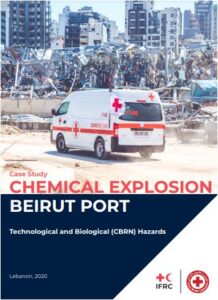Beirut Explosion Case Study: Technological and Biological Hazards
 On 4 August 2020, a huge explosion rocked the city of Beirut, shattering glass and causing extensive damage to buildings and infrastructure within a radius of three kilometres. Hundreds were killed, and many thousands of people injured. The impact of this unprecedented explosion, which registered as a 3.3 magnitude earthquake, was felt as far away as Cyprus. One of the primary concerns immediately following the disaster related to the potentially toxic substances released (or in danger of release) by the explosion, and subsequent fires. Teams of CBRN and environmental experts were immediately deployed to assess the situation. The Lebanese Red Cross’s dedicated CBRN team played a central role in this process.
On 4 August 2020, a huge explosion rocked the city of Beirut, shattering glass and causing extensive damage to buildings and infrastructure within a radius of three kilometres. Hundreds were killed, and many thousands of people injured. The impact of this unprecedented explosion, which registered as a 3.3 magnitude earthquake, was felt as far away as Cyprus. One of the primary concerns immediately following the disaster related to the potentially toxic substances released (or in danger of release) by the explosion, and subsequent fires. Teams of CBRN and environmental experts were immediately deployed to assess the situation. The Lebanese Red Cross’s dedicated CBRN team played a central role in this process.
